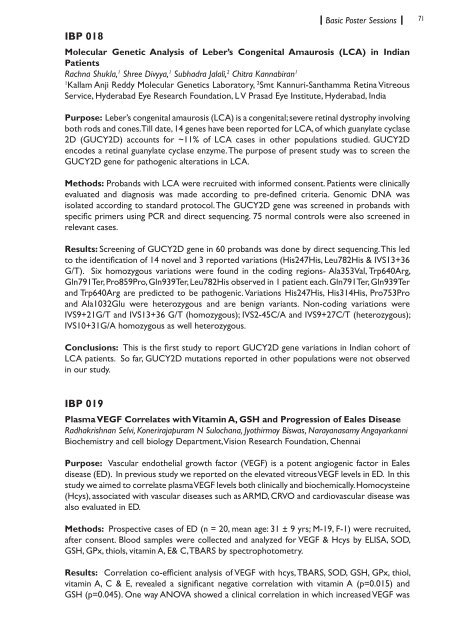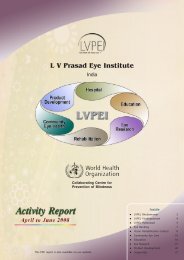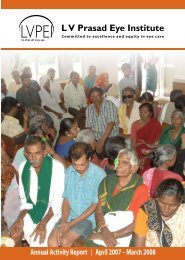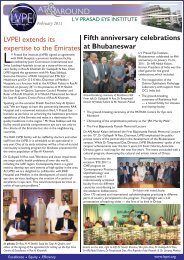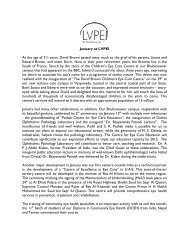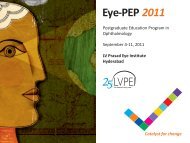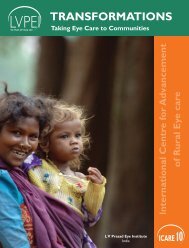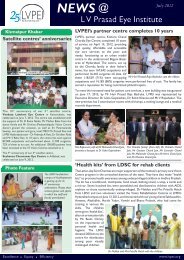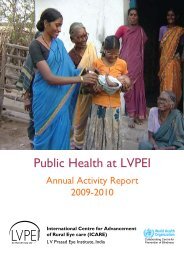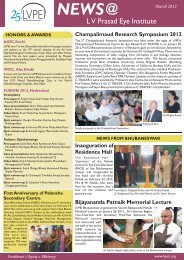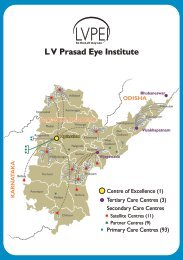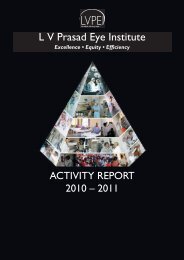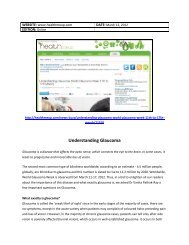IERG Abstracrt Book.indd - LV Prasad Eye Institute
IERG Abstracrt Book.indd - LV Prasad Eye Institute
IERG Abstracrt Book.indd - LV Prasad Eye Institute
You also want an ePaper? Increase the reach of your titles
YUMPU automatically turns print PDFs into web optimized ePapers that Google loves.
IBP 018Basic Poster Sessions71Molecular Genetic Analysis of Leber’s Congenital Amaurosis (LCA) in IndianPatientsRachna Shukla, 1 Shree Divyya, 1 Subhadra Jalali, 2 Chitra Kannabiran 11Kallam Anji Reddy Molecular Genetics Laboratory, 2 Smt Kannuri-Santhamma Retina VitreousService, Hyderabad <strong>Eye</strong> Research Foundation, L V <strong>Prasad</strong> <strong>Eye</strong> <strong>Institute</strong>, Hyderabad, IndiaPurpose: Leber’s congenital amaurosis (LCA) is a congenital; severe retinal dystrophy involvingboth rods and cones. Till date, 14 genes have been reported for LCA, of which guanylate cyclase2D (GUCY2D) accounts for ~11% of LCA cases in other populations studied. GUCY2Dencodes a retinal guanylate cyclase enzyme. The purpose of present study was to screen theGUCY2D gene for pathogenic alterations in LCA.Methods: Probands with LCA were recruited with informed consent. Patients were clinicallyevaluated and diagnosis was made according to pre-defined criteria. Genomic DNA wasisolated according to standard protocol. The GUCY2D gene was screened in probands withspecific primers using PCR and direct sequencing. 75 normal controls were also screened inrelevant cases.Results: Screening of GUCY2D gene in 60 probands was done by direct sequencing. This ledto the identification of 14 novel and 3 reported variations (His247His, Leu782His & IVS13+36G/T). Six homozygous variations were found in the coding regions- Ala353Val, Trp640Arg,Gln791Ter, Pro859Pro, Gln939Ter, Leu782His observed in 1 patient each. Gln791Ter, Gln939Terand Trp640Arg are predicted to be pathogenic. Variations His247His, His314His, Pro753Proand Ala1032Glu were heterozygous and are benign variants. Non-coding variations wereIVS9+21G/T and IVS13+36 G/T (homozygous); IVS2-45C/A and IVS9+27C/T (heterozygous);IVS10+31G/A homozygous as well heterozygous.Conclusions: This is the first study to report GUCY2D gene variations in Indian cohort ofLCA patients. So far, GUCY2D mutations reported in other populations were not observedin our study.IBP 019Plasma VEGF Correlates with Vitamin A, GSH and Progression of Eales DiseaseRadhakrishnan Selvi, Konerirajapuram N Sulochana, Jyothirmoy Biswas, Narayanasamy AngayarkanniBiochemistry and cell biology Department, Vision Research Foundation, ChennaiPurpose: Vascular endothelial growth factor (VEGF) is a potent angiogenic factor in Ealesdisease (ED). In previous study we reported on the elevated vitreous VEGF levels in ED. In thisstudy we aimed to correlate plasma VEGF levels both clinically and biochemically. Homocysteine(Hcys), associated with vascular diseases such as ARMD, CRVO and cardiovascular disease wasalso evaluated in ED.Methods: Prospective cases of ED (n = 20, mean age: 31 ± 9 yrs; M-19, F-1) were recruited,after consent. Blood samples were collected and analyzed for VEGF & Hcys by ELISA, SOD,GSH, GPx, thiols, vitamin A, E& C, TBARS by spectrophotometry.Results: Correlation co-efficient analysis of VEGF with hcys, TBARS, SOD, GSH, GPx, thiol,vitamin A, C & E, revealed a significant negative correlation with vitamin A (p=0.015) andGSH (p=0.045). One way ANOVA showed a clinical correlation in which increased VEGF was


